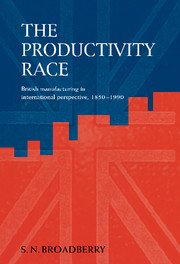Book contents
- Frontmatter
- Contents
- List of figures
- List of tables
- Acknowledgements
- Glossary of terms and company names
- 1 Introduction and overview
- Part 1 measuring comparative productivity performance
- Part 2 explaining compartive productivity performence
- Part 3 reassessing the performance of British industry
- 10 The rise of competition from abroad, 1850–1914
- 11 War and depression, 1914–1950
- 12 Changing markets and technology, 1950–1990
- 13 Concluding comments
- Bibliography
- Index
10 - The rise of competition from abroad, 1850–1914
Published online by Cambridge University Press: 28 October 2009
- Frontmatter
- Contents
- List of figures
- List of tables
- Acknowledgements
- Glossary of terms and company names
- 1 Introduction and overview
- Part 1 measuring comparative productivity performance
- Part 2 explaining compartive productivity performence
- Part 3 reassessing the performance of British industry
- 10 The rise of competition from abroad, 1850–1914
- 11 War and depression, 1914–1950
- 12 Changing markets and technology, 1950–1990
- 13 Concluding comments
- Bibliography
- Index
Summary
Introduction
On average, over the period 1850–1914, labour productivity in British manufacturing was only about half the American level, but on a par with the German level. This reflects the differences in demand conditions and resource endowments examined in chapter 7 and the accumulation strategy appropriate to those conditions, examined in chapter 8. Hence these persistent labour productivity differences should not be seen as evidence of entrepreneurial failure or technological backwardness. By and large, technical choice was rational, given the environment faced by British firms. As writers like McCloskey and Sandberg (1971) argue, in most industries competitive forces acted as a spur to efficiency, with existing rivals or new entrants ready to take up opportunities neglected by incumbent producers. The barriers to adjustment examined in chapter 9 remained relatively weak in most industries during this period.
Aggregates, however, can conceal a great deal, and the disaggregated evidence shows a high degree of variation in the comparative productivity performance of individual industries, as we saw in chapter 2. There were three broad types of industry where Britain did relatively well, i.e. where the Anglo-American labour productivity gap was below the roughly 2:1 for manufacturing as a whole. The first type of industry in which Britain achieved high productivity levels was where craft-based flexible production techniques remained competitive despite the adoption of high throughput mass production methods in the United States. Britain clearly did well in textiles, with labour productivity not far below American levels.
- Type
- Chapter
- Information
- The Productivity RaceBritish Manufacturing in International Perspective, 1850–1990, pp. 157 - 209Publisher: Cambridge University PressPrint publication year: 1997



